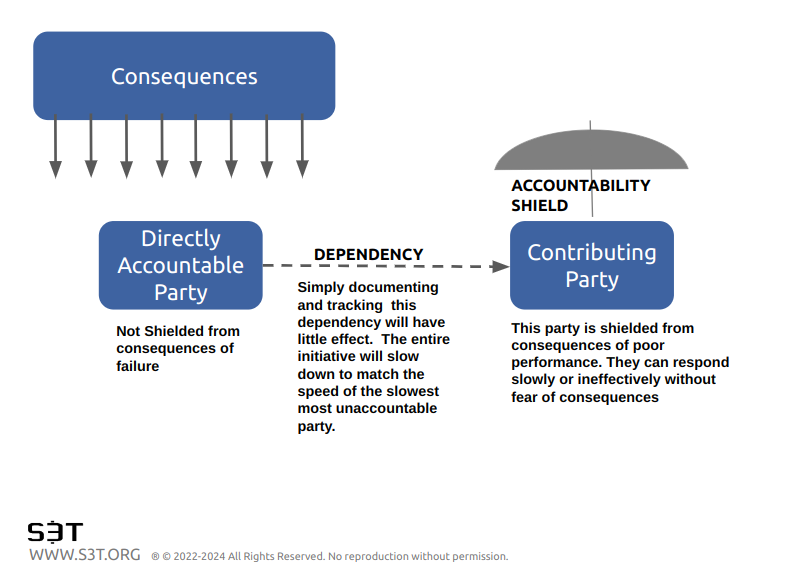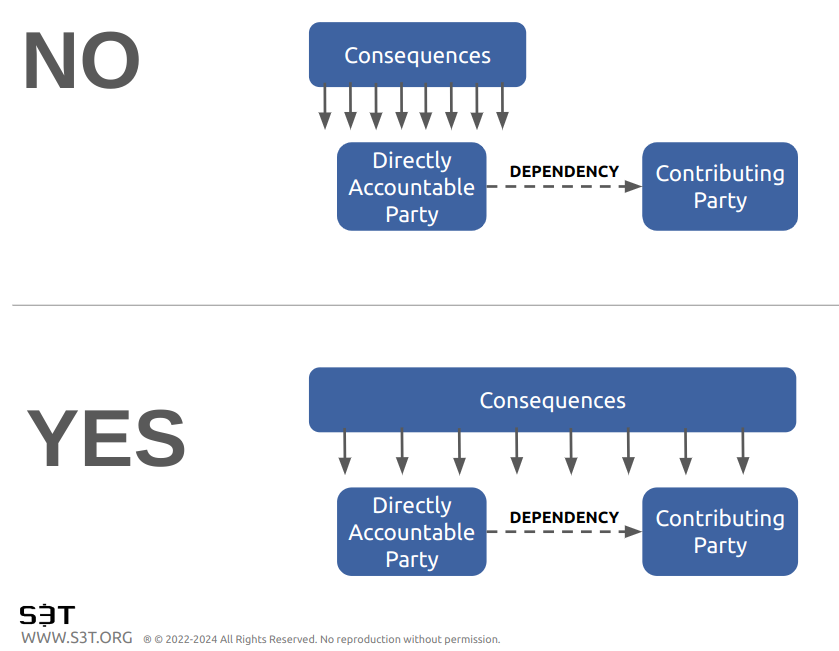⚖️ S3T Playbook: Addressing uneven accountability

Drama involving dependencies is a symptom of uneven accountability: one group feels the full heat of accountability for an outcome but is forced to rely on/wait for another group that doesn't feel the heat. This practical guide will help you resolve this challenge and inspire your organization to structure for more even accountability.
Introduction
If you are involved in projects that matter, you and your team probably spend a lot of time worrying about and dealing with dependencies. Simply put, a dependency is when one group needs something from another group.
How do we handle dependencies? Someone makes a spreadsheet or adds fields in a Jira board (or something like it) and we start tracking the dependencies and reading through them in status meetings.
I think we'd agree, this approach is better than nothing but it's little more than a Band-Aid. Writing dependencies down doesn't solve them. We can report on them in weekly status meetings all we want, but they won't get resolved until we understand and deal with the root cause. We need to learn how to detect and disable accountability shields in our organizations.
What makes dependencies so challenging and disruptive is not that we didn’t write the dependencies down.
What makes dependencies disruptive is that we have uneven accountability: one group is exposed to the consequences of failure and the other is not. The other group is shielded from accountability.
One party is fully exposed to the consequences of failure and the other is not. AND the party that is accountable is forced to rely on the party that is shielded from accountability. That's your root cause.
If you review all the cases in your work where you have the worst most hard-to-manage dependencies, you'll see this pattern: uneven accountability. One Team is able to take advantage of accountability shields.

☂️ Accountability shields degrade performance
The crux of the issue lies in the disparate exposure to the consequences of failure. When one team faces the full brunt of accountability, while another remains insulated, the organization is plagued with a fundamental imbalance. This disparity not only undermines performance but also fosters a culture where accountability is avoided rather than embraced. Everyone starts seeking and setting up accountability shields.
Identifying Accountability Shields
Several mechanisms inadvertently create shelters from accountability:
- Service Level Agreements (SLAs) that become minimum service standards rather than aspirations for excellence. SLAs intended to be “Never Later Than” turn into “Never Sooner Than.”
- Gatekeeper Roles lacking a genuine stake in outcomes. Gatekeeper Roles with no vested interest in outcomes and no sense of urgency to help enable those outcomes.
- Organizational Design Flaws where siloed verticals serve divergent leaders or priorities. Verticals that report to different leaders/priorities.
- Process Loopholes that allow for 'tossing things over the wall' or other forms of shirking of responsibility.
- Flaws in Vendor or Partnership Agreements that don't align interests or consequences.
Equal exposure to consequences is the principle to follow.

Principles for Dismantling Accountability Shields and ensuring even accountability.
Principle 1: Equal Exposure to Consequences
Ensure that all teams and individuals have a stake in the outcomes of their actions, fostering a culture where everyone is equally accountable for successes and failures.
Principle 2: Align Teams with the Source of Clearest Feedback
Teams should be accountable to the stakeholders who provide the clearest feedback and indicators of success or failure. This alignment ensures that feedback is both relevant and actionable, promoting a cycle of continuous improvement.
Principle 3: Avoid Accountability Shields
Actively identify and dismantle structures or processes that protect teams from the consequences of their actions. This involves revisiting SLAs, organizational designs, and any gatekeeping roles to ensure they encourage rather than hinder accountability.
Implementation: A Step-by-Step Approach
- Audit Current Accountability Structures: Evaluate where and how accountability shields exist within your organization.
- Redefine SLAs and Agreements: Revisit SLAs and other agreements to ensure they promote optimal performance rather than minimum standards.
- Restructure for Shared Accountability: Adjust organizational structures and processes to align teams and individuals with the sources of the clearest feedback.
- Foster a Culture of Open Communication: Encourage transparent discussions about dependencies and shared responsibilities, ensuring all teams understand their role in the larger ecosystem.
- Monitor and Adjust: Continuously monitor the impact of these changes on organizational performance and make adjustments as necessary to ensure alignment with overarching goals.
Conclusion
When we allow disparities in accountability, documenting and tracking dependencies have little effect. The entire org or initiative will slow to match the speed of the most unaccountable party.
By recognizing and addressing the disparities in accountability within your organization, you unlock the potential for unparalleled performance and innovation. This journey requires commitment and courage to challenge the status quo, but the rewards—a culture of shared accountability, enhanced performance, and a resilient organizational structure—are well worth the effort. Embrace this guide as a roadmap to transforming your organization into a model of accountable excellence.
Click here to go to the next learning segment: How to cultivate an ownership mindset in vendors and partners
Change Leaders gain an edge by cultivating an ownership mindset in the vendors and partners they work with. Learn how to activate an ownership mindset in your vendors and partners.
